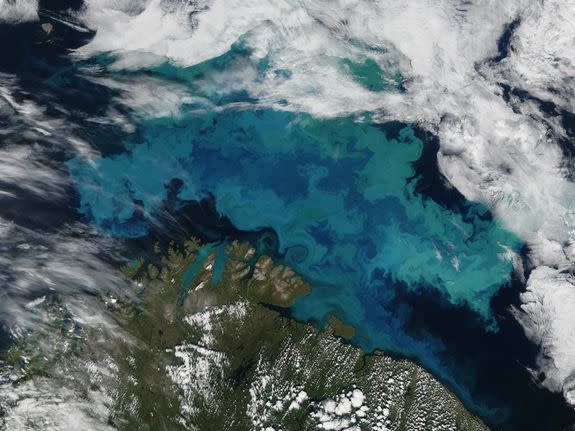Acidifying oceans could hit the very base of the ocean's food web

The bedrock of the ocean's food chain, on which whales, sharks, and octopi ultimately rely, are tiny bits of photosynthetic algae called diatoms. They come in thousands of shapes and are imperceptible to the human eye.
If their populations collapse or shrink, there could be dramatic reverberations throughout the vast marine food web.
Scientists have now identified a climate change-related threat to diatoms, and it comes from a known and growing threat: Ocean acidification.
SEE ALSO: Scientists intentionally acidify sea water to show just how screwed coral reefs really are
In a study published Wednesday in the journal Nature, scientists collected a species of diatom from the ocean and exposed it to increased seawater acidity — akin to the projected ocean acidity levels by the end of the century. They found that more acidic waters hindered diatoms from getting the nutrition they need, specifically iron, for their numbers to grow.
And if diatom populations were to plummet, there would be global implications beyond the sea.
Diatoms float near the ocean's sunlit surface, and they suck carbon dioxide from the atmosphere and then use this carbon as a key nutrient. According to the National Oceanic and Atmospheric Administration (NOAA), the ocean absorbs 30 percent of the carbon dioxide in the atmosphere, and much of this is consumed by hungry, surface-dwelling diatoms.
The diatoms take in the carbon, but release oxygen — so much so that "Diatoms supply the oxygen in every fourth breath you take," according to NOAA. Eventually these heavy diatoms sink to the ocean floor, where they naturally "sequester" this carbon far from the atmosphere.
If diatom numbers fall, so might the ocean's natural ability to gulp carbon dioxide, a potent and long-lived greenhouse gas, out of the air. This could speed up global warming.

Image: NASA
Although researchers are not yet projecting dire circumstances for both vast regions of our oceans and the planet's climate — the potential cascading effects of their collapse are troubling.
"It's significant and worrisome," said Andrew Allen, who researches microbial oceanography and ecology at the Scripps Institution of Oceanography, in an interview. Allen was a coauthor of the study.
So, how can acidifying oceans limit diatom growth?
The problem begins with the burning of fossil fuels. Burning fuels like oil, coal, and natural gas releases heat-trapping carbon dioxide into the atmosphere, causing the planet's temperature to increase. Today, carbon dioxide levels are the highest they've been in at least 800,000 years, and global average surface temperatures have been setting all-time records.
Carbon dioxide in the air naturally reacts with sea water, producing carbonic acid and incrementally increasing the acidity of the seas. This increase in carbonic acid, however, results in fewer carbonate molecules (technically a carbonate molecule that's negatively charged, or an ion) available. And this is key: The researchers found that fewer carbonate molecules interfere with diatoms' ability to "grab" onto iron — a vital nutrient that enables them to multiply and flourish.

Image: Alaska fisheries science center/noaa
According to the researchers, due to ocean acidification, the carbonate near the ocean's surface — where most of the acidification is taking place — will decline by nearly 50 percent during this century.
So, although much more research is needed to build upon this initial study, this could spell doom for diatoms in vast swathes of the ocean, particularly seas in the Southern Ocean around Antarctica that are already iron-deficient.
Falling diatom populations can stoke a vicious "feedback loop," wherein there's fewer diatoms to suck carbon out of the air and eventually sequester it near the ocean floor. Accordingly, there will be more carbon dioxide left in the atmosphere, further acidifying the oceans and making it more difficult for diatom populations to grow.
This effect, the researchers emphasize, will be most prominent in oceans that are already low in iron.
"In these regions, high concentrations of atmospheric carbon dioxide could decrease phytoplankton growth, restricting the ability of the ocean to absorb carbon dioxide and thus leading to ever higher concentrations of carbon dioxide accumulating in the atmosphere," said Jeff McQuaid, a microbial and environmental genomics researcher and the study's lead author, in a statement.

Image: Wikimedia commons
Like many carefully designed studies, this one took place in a laboratory setting where researchers like McQuaid and Allen could control all the variables. But out in the open ocean, the effects on diatoms could be different — and may not result in such an adverse feedback loop. That's why it's too early to say that such an effect will likely occur.
"Ecological systems are complex and it's hard to predict how systems might compensate or adjust," Allen said.
But if the laboratory results are similar to those in the actual ocean, the oceans might one day speed up global warming, rather than dampening the rate at which the planet's climate is changing.
In other words, the oceans may one day go from climate change friend to a foe.
